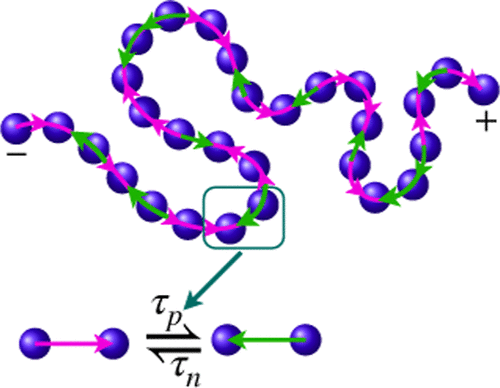Folding-Unfolding Transition of Active Polymer on the Reconfiguration of Bidirectional Tangential Active Force
IF 5.2
1区 化学
Q1 POLYMER SCIENCE
引用次数: 0
Abstract
The role of active stress on the conformational dynamics of a polymer has drawn significant interest due to its potential applications in understanding the energy landscape of protein structures, buckling of biopolymers, genomic spatial organization and their large-scale coherent dynamics. We present a model of bidirectional active force that acts along the polymer’s tangent, with its direction stochastically reversing between head-to-tail and tail-to-head orientations. The active polymer shows a structural transition from a random coil-like state to a compressed state with variations in the active force, directional (polarity) reversal rate, and their fraction. Furthermore, the polymer reswells and stretches more than its passive limit for a large active force. The polymer’s radius of gyration follows the ideal chain-like scaling relation, Rg2∼Nm2ν with an exponent ν ≈ 1/2, in both the compressed and swelled states. The bidirectional active force drives dynamical transitions, where the effective diffusivity abruptly shifts from a linear to quadratic increase. Similarly, in the regime of large activity, the linear decrease of the longest relaxation time of the polymer changes behavior to a power-law behavior Pe–4/3 with Péclet number. We have shown that the active polymer’s conformational, relaxation, and diffusive behaviors display a transition from an active polar linear polymer model (APLP) to an active Brownian particle (ABP) polymer model with the increase in the fraction of the opposite polarity and their reconfiguration time.

活性聚合物的折叠-展开跃迁对双向切向主动力重配置的影响
主动应力在聚合物构象动力学中的作用引起了人们的极大兴趣,因为它在理解蛋白质结构的能量景观、生物聚合物的屈曲、基因组空间组织及其大规模相干动力学方面具有潜在的应用。我们提出了一个双向有源力的模型,它沿着聚合物的正切方向作用,其方向在从头到尾和从头到尾的方向之间随机逆转。活性聚合物表现出从随机线圈状状态到压缩状态的结构转变,并随活性力、方向(极性)反转率及其分数的变化而变化。此外,在较大的主动力作用下,聚合物会重新膨胀并拉伸超过其被动极限。在压缩和膨胀状态下,聚合物的旋转半径都符合理想的链状缩放关系,即Rg2 ~ Nm2ν,其指数ν≈1/2。双向主动力驱动动态转变,其中有效扩散率突然从线性增加到二次增加。同样,在大活度下,聚合物最长弛豫时间的线性降低使其行为随pacclet数的增加而改变为幂律行为Pe-4/3。研究结果表明,随着极性相反部分的增加和重新配置时间的增加,活性聚合物的构象、弛豫和扩散行为呈现出从活性极性线性聚合物模型(APLP)向活性布朗粒子(ABP)聚合物模型的转变。
本文章由计算机程序翻译,如有差异,请以英文原文为准。
求助全文
约1分钟内获得全文
求助全文
来源期刊

Macromolecules
工程技术-高分子科学
CiteScore
9.30
自引率
16.40%
发文量
942
审稿时长
2 months
期刊介绍:
Macromolecules publishes original, fundamental, and impactful research on all aspects of polymer science. Topics of interest include synthesis (e.g., controlled polymerizations, polymerization catalysis, post polymerization modification, new monomer structures and polymer architectures, and polymerization mechanisms/kinetics analysis); phase behavior, thermodynamics, dynamic, and ordering/disordering phenomena (e.g., self-assembly, gelation, crystallization, solution/melt/solid-state characteristics); structure and properties (e.g., mechanical and rheological properties, surface/interfacial characteristics, electronic and transport properties); new state of the art characterization (e.g., spectroscopy, scattering, microscopy, rheology), simulation (e.g., Monte Carlo, molecular dynamics, multi-scale/coarse-grained modeling), and theoretical methods. Renewable/sustainable polymers, polymer networks, responsive polymers, electro-, magneto- and opto-active macromolecules, inorganic polymers, charge-transporting polymers (ion-containing, semiconducting, and conducting), nanostructured polymers, and polymer composites are also of interest. Typical papers published in Macromolecules showcase important and innovative concepts, experimental methods/observations, and theoretical/computational approaches that demonstrate a fundamental advance in the understanding of polymers.
 求助内容:
求助内容: 应助结果提醒方式:
应助结果提醒方式:


